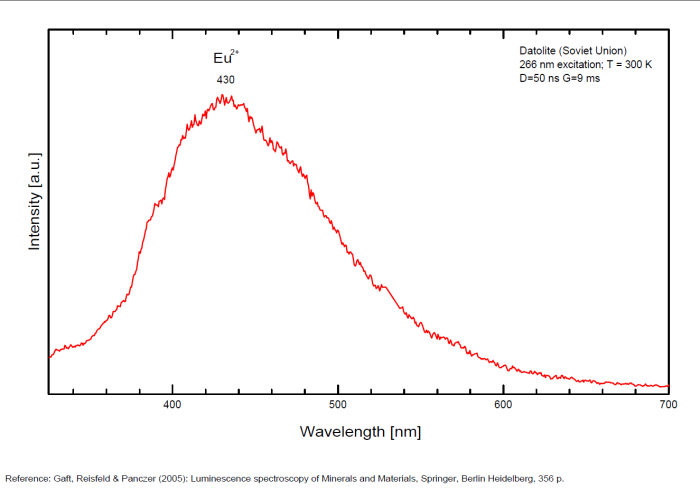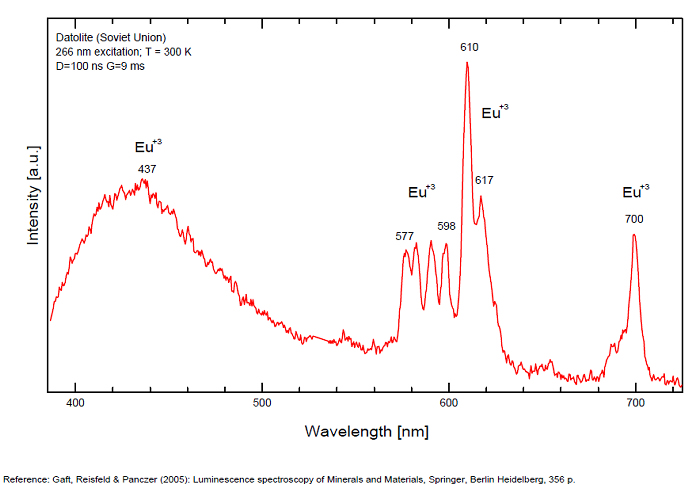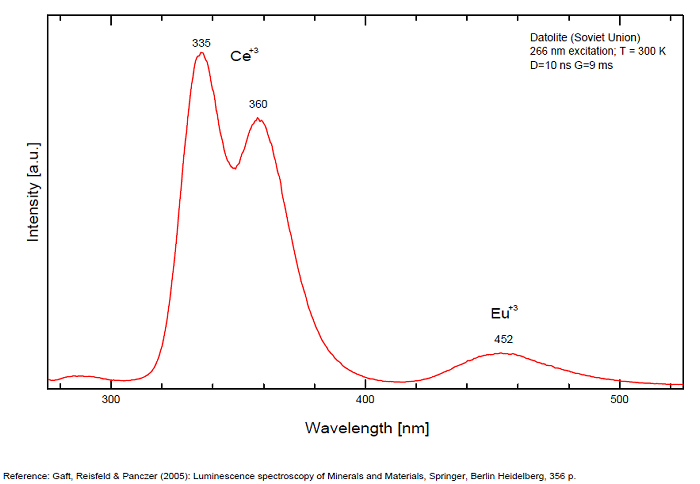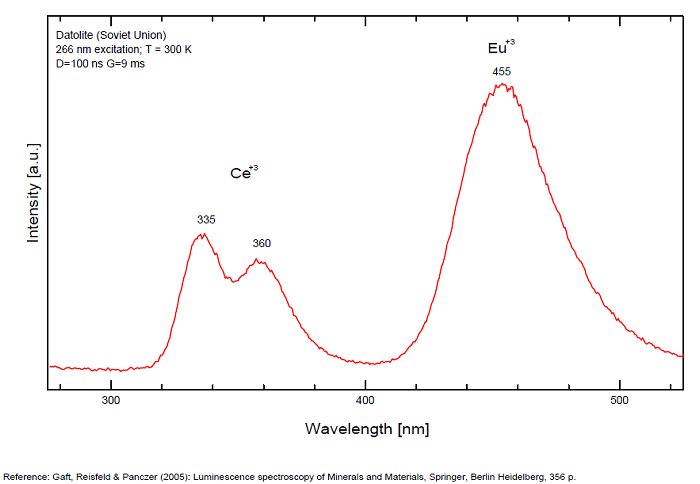Database of luminescent minerals
DATOLITE
Chemical formula: Ca2B2Si2O8(OH)2
Family: Silicates
Status: IMA-GP
Crystal system : Monoclinic
Display mineral: NON
Luminescence:
Longwave UV (365nm) colors: |
Yellowish White , Yellow , Tawn , | ||
Midwave UV (320nm) colors: |
Yellowish White , Yellowish White , | ||
Shortwave UV (254nm) colors: |
Pale Yellow , Pale Yellow , Yellow , | ||
Do you have a photo of this mineral you would like to see in the gallery? Contact us!
Phosphorescence (in the common sense of the term) observable with the naked eye:
No data
Activator(s) and spectrum:
Activator(s): Eu2+, Ce3+, Eu3+, Mn2+ , Yb2+,
Peaks in the spectrum (nm):
Ce3+: 335, 350, 360, 370nm
Eu2+: 430, 445, 455nm
Yb2+: 520nm
Mn2+: 565nm
Eu3+: 577, 598, 510, 616 - 617, 700nm
(All repl. Ca2+)

Spectrum: Michael Gaft, Petah Tikva, Israel. Plot: Institute of Mineralogy, University of Vienna, Austria, with permission of the authors.
Spectrum Galery:



 ...
...Comments on spectrum and activators:
Luminescence centers Eu2+, Yb2+ and Mn2+, characterize steady-state spectra of datolite (Gaft et al. 1979). By using laser-induced time-resolved spectroscopy Gaft and al. were able to detect the following emission centers: Mn2+, Ce3+, Eu2+, Eu3+, Sm3+, Dy3+
Best localities for fluorescence (*):
- Paterson, Passaic Co., New Jersey, USA;
- Ca de Giannasi, Frassinoro, Modena Province, Emilia-Romagna, Italy;
- Mendicino County, California, USA (SW+LW bright lemon yellow);
- Skaggs Springs, Warm Springs Dam, Coast Range, Sonoma Co., California, USA;
- Mont Saint-Hilaire, La Vallée-du-Richelieu RCM, Montérégie, Québec, Canada;
(*)The data are not exhaustive and are limited to a few remarkable localities for fluorescence
Bibliographic reference for luminescence:
- The Henkel Glossary of Fluorescent Minerals, Dr. Gerhard Henkel, Published by the FMS, 1989 ,
- Fluorescence: Gems and Minerals Under Ultraviolet Light, Manuel Robbins, 1994, Geoscience Press, ISBN 0-945005-13-X ,
- Luminescence Spectroscopy of Minerals and Materials, M. Gaft, R. Reisfeld, G. Panczer, Springer Editor, ISBN: 10 3-540-21918-8 ,
- Luminescent Spectra of Minerals, Boris S. Gorobets and Alexandre A. Rogojine, Moscow, 2002 ,
Reference for luminescence on the Internet:
- MONT-SAINT-HILAIRE, History, Geology, Mineralogy, Laszlo HORVATH, The Canadian Mineralogist, Special Publication 14, 2019
Mineralogical reference on the Internet:
 http://www.mindat.org/show.php?name=Datolite
http://www.mindat.org/show.php?name=Datolite
 http://webmineral.com/data/Datolite.shtml
http://webmineral.com/data/Datolite.shtml
Internet Search:
 Image search on 'Google Images'
Image search on 'Google Images'
 Search for documents in all languages on Google
Search for documents in all languages on Google
A request providing no result means only that no such reference exists in the database, but it does not mean that what you are looking for does not exist, just not to our knowledge. If you think you have found an error or omission, please let us know via the contact page being sure to cite the source of information.

